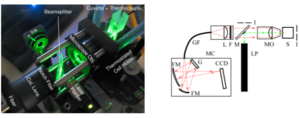DIY Raman spectroscope
| Projects | |
|---|---|

| |
| Participants | V |
| Skills | |
| Status | Planning |
| Niche | Electronics |
| Purpose | Promotion |
The purpose is to build a Raman spectrometer, inspired by the paper of Mohr C, Spencer CL, Hippler M (2010) Inexpensive Raman Spectrometer for Undergraduate and Graduate Experiments and Research. Journal of Chemical Education 87: 326–330. doi:10.1021/ed800081t [1] providing a base. (wish i could add a template for simple citing).
A Raman spectrometer is a tool that can help identify molecules.
Note. This Raman spectrometer will most likely bee of low resolution compared to the high end commercial Raman spectrometers available.
Introduction
A Raman spectrometer consists basically of a monochromatic light source, for example a laser that emits a single wavelenght that is aimed at a a beam splitter in a 90 degree angle causing the monocrhromatic light pass through an inverted lens hitting the sample, due to interactions different light frequencies are reflected straight back towards the cutoff filter into the detector.
To quote wiki: The laser light interacts with molecular vibrations, phonons or other excitations in the system, resulting in the energy of the laser photons being shifted up or down. The shift in energy gives information about the vibrational modes in the system.[2]
The Raman effect is based on molecular deformations in electric field E determined by molecular polarizability α. The laser beam can be considered as an oscillating electromagnetic wave with electrical vector E. Upon interaction with the sample it induces electric dipole moment P = αE which deforms molecules. Because of periodical deformation, molecules start vibrating with characteristic frequency υm.
Amplitude of vibration is called a nuclear displacement. In other words, monochromatic laser light with frequency υ0 excites molecules and transforms them into oscillating dipoles. Such oscillating dipoles emit light of three different frequencies when:
1. A molecule with no Raman-active modes absorbs a photon with the frequency υ0. The excited molecule returns back to the same basic vibrational state and emits light with the same frequency υ0 as an excitation source. This type if interaction is called an elastic Rayleigh scattering.
2. A photon with frequency υ0 is absorbed by Raman-active molecule which at the time of interaction is in the basic vibrational state. Part of the photon’s energy is transferred to the Raman-active mode with frequency υm and the resulting frequency of scattered light is reduced to υ0 - υm. This Raman frequency is called Stokes frequency, or just “Stokes”.
3. A photon with frequency υ0 is absorbed by a Raman-active molecule, which, at the time of interaction, is already in the excited vibrational state. Excessive energy of excited Ramanactive mode is released, molecule returns to the basic vibrational state and the resulting frequency of scattered light goes up to υ0 + υm. This Raman frequency is called AntiStokes frequency, or just “Anti-Stokes”.
About 99.999% of all incident photons in spontaneous Raman undergo elastic Rayleigh scattering. This type of signal is useless for practical purposes of molecular characterization. Only about 0.001% of the incident light produces inelastic Raman signal with frequencies υ0 ± υm. [3]
Realization
In the Hippler paper a DIY raman spectrometer using a low power green laser is build at a cost close to $5000 while this is quite a revolution compared to the old industry prices i beleive a DIY raman spectrometer can be constructed much cheaper.
Practice
Given the fact that the equipment that surrounds the spectrometer in this setup performs adequate the spectrometer itself will serve as the core of the Raman spectrometer, inspired by the sciencemadness the starting point before attempting to create my own spectrometer would be an ebay offer on an unaligned Science surplus 1800 lines/mm grating spectrometer at the price of 200$ [4]. Ideally i would love to contruct my own spectrometer if anyone is willing to help me out on this it should bee possible to build a spectrometer that is superior and of lower cost.
The remaining components of the Raman spectroscope are a monochromatic light source (intense continous laser light) estimated 25-50$, for the beamsplitter i will take out the beamsplitter that is in 1 of my old uv/vis detectors otherwise the cost price for buying a simple beam splitter is between 20-50$, As a filter i will use the 25mm Raman Edge for 532 nm, Omega [6]. Optionally a laser trap could be added this should reduce noise [7].
The box from one of the old uv/vis detectors could be used containing the complete setup this should also reduce any scatter noise.
Software for windows is provided with the spectrometer but perhaps it would be nice to write something for a linux or posix environment.
!__IMORTANT__! : protective glasses blocking the wavelenght of the laser and preferably IR are required for safety when working with a high powered laser.
References
[1] http://pubs.acs.org/doi/abs/10.1021/ed800081t
[2] https://en.wikipedia.org/wiki/Raman_spectroscopy
[3] http://content.piacton.com/Uploads/Princeton/Documents/Library/UpdatedLibrary/Raman_Spectroscopy_Basics.pdf
[4] http://www.ebay.com/itm/Compact-Fiber-Coupled-CCD-Spectrometer-Kit-DIY-/321080218370?pt=LH_DefaultDomain_0&hash=item4ac1df5302
[5] http://www.ebay.com/itm/NEW-THORLABS-LA1951-C-N-BK7-PLANO-CONVEX-LENS-F-25-4-MM-MOUNTED1050-1620-NM-ARC-/121062768207?pt=LH_DefaultDomain_0&hash=item1c2fe73e4f
[6] http://www.ebay.com/itm/Optical-Filter-541-AELP-25mm-Raman-Edge-for-532-nm-Omega-/310488005017?pt=LH_DefaultDomain_0&hash=item484a86f999
[7] http://www.ebay.com/itm/Laser-Beam-Block-Trap-beam-dump-with-Mount-/281042546257?pt=LH_DefaultDomain_0&hash=item416f70ee51